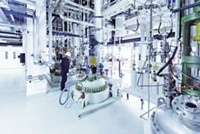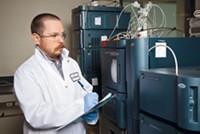Advertisement
Grab your lab coat. Let's get started
Welcome!
Welcome!
Create an account below to get 6 C&EN articles per month, receive newsletters and more - all free.
It seems this is your first time logging in online. Please enter the following information to continue.
As an ACS member you automatically get access to this site. All we need is few more details to create your reading experience.
Not you? Sign in with a different account.
Not you? Sign in with a different account.
ERROR 1
ERROR 1
ERROR 2
ERROR 2
ERROR 2
ERROR 2
ERROR 2
Password and Confirm password must match.
If you have an ACS member number, please enter it here so we can link this account to your membership. (optional)
ERROR 2
ACS values your privacy. By submitting your information, you are gaining access to C&EN and subscribing to our weekly newsletter. We use the information you provide to make your reading experience better, and we will never sell your data to third party members.
Environment
New Digs For Drug Manufacture
by James Bruno
November 9, 2015
| A version of this story appeared in
Volume 93, Issue 44
The following is a guest editorial by James Bruno, a pharmaceutical chemicals market consultant and president of Chemical & Pharmaceutical Solutions.
Over the years, pharmaceutical manufacturing has been driven around the world and back again by economic and political forces as well as by trends in the production and purchasing of active pharmaceutical ingredients (APIs).
Consider that, in the earliest days of the drug industry, pharmaceutical company research centers in the U.S. and Europe were also the global centers for the manufacture of APIs. In the years that followed, tax incentives for manufacturing, fueled by economic growth in countries such as Ireland, Puerto Rico, and Singapore, moved factories to those regions of the world. Economic drivers also ultimately pushed a huge quotient of production to India and China as well as to Eastern Europe.
Today, we see API manufacturing returning to the U.S. and Western Europe as a result of rising costs, tougher environmental regulation, and a growing concern over quality and safety in Asia. In addition, tax incentives in Ireland and Puerto Rico have dwindled, and Singapore has shifted its focus to industries such as information technology. Western contract manufacturers on hand at the CPhI exhibition in Madrid last month cited the return of work from Asia as a major component of revenue growth in 2015 (see page 18).
But as the industry pulls back to its original base, one might ask whether there are regions elsewhere in the world that the industry can turn to for low-cost, high-quality manufacturing of APIs.
There is talk of potential programs in the Middle East, Africa, and other Pacific Rim countries, such as Vietnam. Most of it, however, involves discussion of repackaging and final-dosage manufacturing. Although these downstream activities could establish a foothold for the industry in regions with huge market potential, the lack of infrastructure and financial backing creates obstacles to establishing API production. Difficulty in attaining raw materials, solvents, and research expertise in new locales also presents problems that cannot be solved in a short period of time.
But there are stirrings of scientific and technological change in the pharmaceutical industry that may downsize these problems, unlocking a wholly new geography for API production as manufacturing trends toward light industry.
First of all, researchers are developing new, more potent drugs. Thus the volume of API being produced is declining. This could reduce the capital investment required as smaller production units take the field. The factories themselves will be smaller and much more efficient—engineering companies are already developing modular, nearly “plug and play” plants. This could get complex technologies into places where one could not have imagined traditional API manufacturing getting a foothold.
Second, the industry is catching up by evolving beyond batch processing. Continuous-flow production could be a real game changer, reducing the size of factories and significantly cutting the cost of operation. New, semiautomatic technologies have proven effective at running complex processes safely, which will be a critical asset in regions lacking a traditionally skilled workforce.
But technology is more than simply catching up in API manufacturing. It is becoming downright futuristic. Recently, for example, DSM introduced small flow reactors built using 3-D printers. These could conceivably be produced in large quantities anywhere in the world, potentially realizing dramatic cost savings. The repair shop of the future could look quite different from what we are used to today. Instead of a rack of tools, one could eventually see a row of 3-D printers.
Could what has traditionally been a complex industry requiring high technology and expensive equipment be turned around to develop a new manufacturing landscape? There is every indication that barriers to entry once considered sacred are coming down. Will it happen? Who’s to say? On the other hand, who expected to see 3-D printers, let alone see them making chemical reactors, 10 years ago—back when we expected to have to ship APIs to a third party for formulation?
But that was back in the dark ages.
Views expressed on this page are those of the author and not necessarily those of ACS.




Join the conversation
Contact the reporter
Submit a Letter to the Editor for publication
Engage with us on Twitter